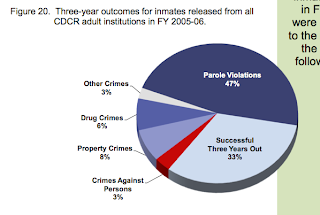SACRAMENTO — Gov.
Jerry Brown on Wednesday named a vocal advocate of shorter sentences and community treatment to run the state’s crowded and troubled prison system.
Brown announced the selection of Jeffrey Beard, 65, the retired former Pennsylvania prisons chief, to succeed Matthew Cate, who stepped down last month after four years as secretary of corrections in California. Cate is now leader of the California State Assn. of Counties.
Beard, whose appointment is subject to Senate confirmation, spent nearly four decades in corrections in Pennsylvania, starting as a counselor and advancing to prison warden, eventually spending nine years as department head. He completed an expansion of that state’s prison system, including the addition of 32,000 inmate beds.
He left in 2010, advocating for laws that put more criminals into work-treatment programs instead of prisons, telling lawmakers that an “over-reliance” on locking up non-serious offenders did little to improve public safety.
Though an official start date was not announced, Beard joins Brown’s administration at a critical time. The Department of Corrections and Rehabilitation has until Jan. 7 to produce a plan for reducing prison crowding or face the renewed threat of federal orders to release inmates early.
In addition, a federal receiver is attempting to negotiate terms for California to resume control over the delivery of healthcare to inmates. And the parole and healthcare divisions are laying off staff.
In announcing the appointment, Brown said Beard “has arrived at the right time to take the next steps in returning California’s parole and correctional institutions to their former luster.”
Beard’s successor in Pennsylvania says Beard will fit right in.
“I think you guys hit a home run,” said Pennsylvania Corrections Secretary John Wetzel.
Wetzel, who was appointed eight months after Beard retired, said the former director weighed in frequently with crucial advice and provided input on new legislation intended to reduce prison crowding in that state and on expanding community treatment and diversion programs.
In 2008, Beard lent support to a proposal to ease county jail crowding by sending felons serving more than two years to state prison. But it allowed for medical release and early release of nonviolent offenders who completed treatment and education programs.
Andy Hoover, legislative director for the Pennsylvania branch of the
American Civil Liberties Union, said Beard played an active role in developing corrections policies and promoting them before the Legislature.
But Beard has critics as well, some of whom hold him responsible for expanding the use of solitary confinement in Pennsylvania and for a two-month moratorium on parole releases after the murders of two
Philadelphia police officers. The moratorium caused such overcrowding that Pennsylvania began sending inmates to serve time in other states.
Hoover said Beard was caught in a political bind, carrying out policies he had not set. “He was in an unfortunate position,” Hoover said. “It was very much out of his hands.”
Corrections historian Dan Berger, who was working on his doctoral degree at the
University of Pennsylvania at the time, disagrees.
“Beard does not have a good reputation on health and human rights in prison,” Berger said. “He gives more rhetoric to sentencing reform than believes it.”
After retiring in 2010, Beard joined
Pennsylvania State University‘s Justice Center for Research, and he has worked as a private consultant to a number of states, including California. He advised Sacramento on litigation over the care and housing of mentally ill offenders and has toured California prisons.
Beard is not shy about voicing opinions on where the criminal justice system fails. In 2010, he told Pennsylvania lawmakers that heavy reliance on incarceration of low-level offenders “has proven to have limited value in maintaining public safety.”
“We must stop treating all offenders the same and move away from the ‘get tough on crime’ philosophy of locking up less serious offenders for longer periods of time,” he told them.
In a 2005 commentary in an industry publication, Beard called for a rethinking of “who really belongs in prison” and an end to the then-popular “scared straight” programs he felt increased the likelihood that freed inmates would commit future crimes. “We must have the will to put an end to feel-good and/or publicly popular programs that simply do not work,” Beard wrote.
Corrections officials said Beard was unavailable Wednesday but released a single statement quoting the incoming secretary as saying he was “honored” to be appointed “for this important public safety position.”
paige.stjohn@latimes.com

 Jeffrey Beard, 65, the retired former Pennsylvania prisons chief, has been named to run California’s prison system. (Pennsylvania Department of Corre, )
Jeffrey Beard, 65, the retired former Pennsylvania prisons chief, has been named to run California’s prison system. (Pennsylvania Department of Corre, )


